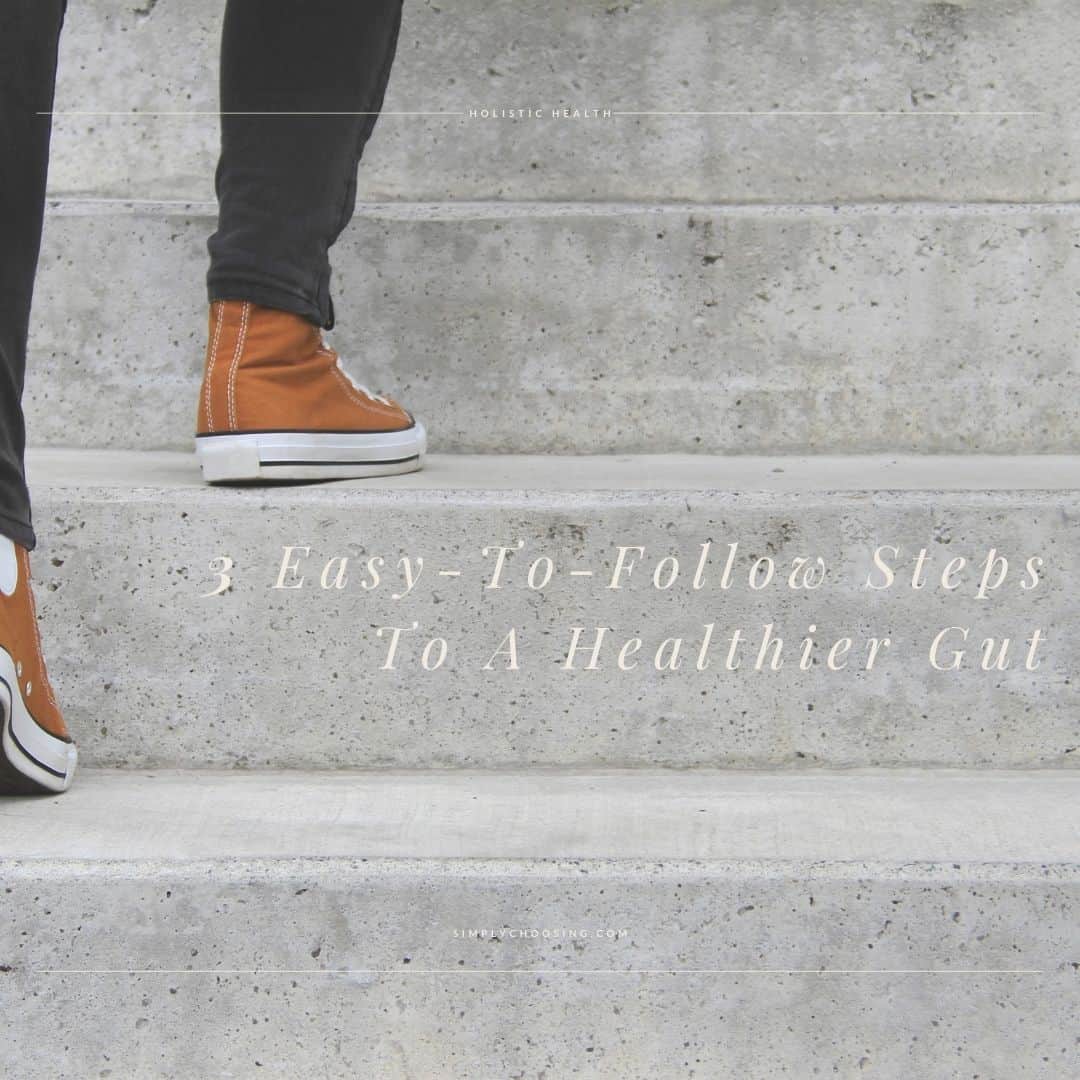Disclosure: Please note that this post may contain affiliate links, meaning that I get a commission if you decide to make a purchase through my links, at no cost to you. Please refer to my Privacy Policy for more information.
What will you get from this blogpost:
- A brief introduction to how the gut prompts you to make lifestyle changes.
- Example symptoms of a sick gut.
- Three easy-to-follow steps to a healthier gut.
The gut is a fascinating organ. It can keep up with healing and restoring your body to health, but sometimes that’s just not enough. It needs help. Today, we’ll go over three easy-to-follow steps to a healthier gut that keeps your gut – and you – healthy and vibrant.
The gut is the body’s largest organ
We rarely associate unpleasant body odor, poor skin, or the loss of youthful radiance with the health of our gut. Yet it is the largest organ we have and is directly connected to all other organs in the body. Something many people are simply not aware of.
Can you imagine: The intestinal plexus has a nervous system that could easily circle the earth one and a half times! So who would actually believe that there is no connection between your health and the gut?

Symptoms of a sick gut are rarely the result of a single night of drinking or the stress of the last two weeks. They often accumulate over years and decades and can then, if not treated, develop into real diseases.
Colitis and Crohn’s disease, for example, don’t usually start with constipation or bloating in your forties. In many cases, the beginnings are in childhood when school stress or anxiety prevent true nighttime relaxation and thus intensive detoxification of the body.
But how do you know that your gut is begging for help?
Your body is a miracle worker and finds many ways to communicate with you. It can balance, shift, and repair many things to keep the most important body functions going.
However, at some point, it has to find ways to eliminate waste when the gut is overloaded. When the elimination process is not possible due to gut problems, you will most likely notice symptoms such as:
- foul breath,
- bloating,
- sweating,
- diarrhea and constipation due to fermentation and rotting.

Gut problems can also show in your face. Many people are biologically young but look much older due to premature aging. Poor posture, gray hair, and cellulite are all signs of premature aging due to an excess of old waste products in the gut.
Therefore, your wrinkles, skin color, and connective tissue elasticity reveal a lot about the health of your gut.
In the long run, your psyche can be affected too. This is because 90% of the happiness hormone serotonin is produced in the gut. Lack of energy, low self-esteem, and depression are therefore also among the side effects of a sick gut.
As a rule of thumb, a healthy person should have a bowel movement at least once a day, preferably twice or more, in the morning and in the afternoon. This serves to eliminate the waste products of metabolism so that they do not remain in the body and cause discomfort.
How long can your gut endure if it is chronically deficient?

The gut is connected to all organs and keeps the biological rhythm of life going – your life fire – so to speak. To do this, the gut digests the food pulp from the stomach by first neutralizing the stomach acid with the help of enzymes. For this purpose, it has a protective layer so that the intestinal wall is not attacked by the acid.
Here there are about 100 trillion different gut bacteria that ensure the detoxification of harmful substances and the assimilation of nutrients in your body. This unbelievable diversity of microorganisms, therefore, plays a fundamental role in determining whether you are sick or healthy.
The gut is a miracle and can keep you healthy for years, even decades, despite a bad environment. But we do not want to wait until it is too late to bring our health to the highest level. Right?
So, depending on your lifestyle, thorough cleansing may be needed from time to time to regenerate the gut and restore bodily functions to the best possible level.
While daily detoxification and deep gut cleansing are vital for a vibrant life, these three steps to a healthier gut can still promote gut health:
Three steps to a healthier gut

1. Step to a healthier Gut: Effective Microorganisms
A first step can be to build a healthy microbiome by integrating gut-healing fermented foods into your daily routine.
Here you can easily buy fermented products in the supermarket (sauerkraut, kimchi, etc.) or ferment them yourself. Ideally, you also drink the “waste products”, i.e. the juice from the fermentation. This juice contains many beneficial lactic acid bacteria to strengthen your gut.
In addition to fermented vegetables, I personally take probiotics and prebiotics daily. These also help to build a healthy microbiome. Personally, I like the products from OMNI-BiOTiC. (No Affiliate Link).

2. Step to a healthier gut: Gut Cleansing
Even if you eat fermented foods, you can not avoid detoxification. This is because the gut is not ready to rebuild itself after years of depleting your own body. Therefore, intestinal pockets must be emptied, fecal stones and biofilm (thin layer of mucus) must be removed, and inflammation must be relieved.
There are several ways to cleanse the gut in this regard. The simplest is to take psyllium husks daily. This is because swelling ingredients like psyllium husks can help flush out waste from the emptied intestinal pockets by stretching the gut.
Fresh dietary fiber, minerals, and vitamins then promote the breakdown of metabolic products when sufficient binders are present. Studies have shown that zeolite clay in particular can provide excellent support.
- For a simple detox, drink 1-2 teaspoons of psyllium husks with a large glass of water (at least 3 dl) on an empty stomach. Do not eat breakfast for at least 30 minutes afterwards. Repeat the intake daily until you feel an effect on your body.
- You can have a greater benefit by adding zeolite clay to the psyllium husks. To do this, mix 1-2 teaspoons of psyllium husks with 1 teaspoon of clay and drink it with a large glass of water on an empty stomach. Again, do not eat breakfast for at least 30 minutes. Repeat this daily until you feel an effect on your body.

These procedures require time, patience, and perseverance. You will probably have to wait at least 1 month to see any changes.
Be aware that such a cleanse will most likely have an effect on your hormonal balance and psyche as well. Your temperature balance will regulate, your sense of taste will change, and your sensitivity may seem unfamiliar.
3. Step to a healthier gut: Drinking Water
What you need to remove the harmful substances from the body is above all pure, still water. Here you should pay attention to the quality of the water, especially during detoxification, and ideally avoid tap water altogether.
Teas, which support the detoxification activity of the body, should also contain bitter substances to strengthen the liver and may have an anti-inflammatory effect (dandelion, nettle, etc.). This will strengthen the healing power of your body and initiate elimination processes.
Avoid coffee, especially during detoxification activities.

Countless irritants burden your body and psyche. Not only chemicals and environmental toxins but also stress, anxiety, and lack of sleep endanger your inner balance, promote hyperacidity and weaken the body’s detoxification capacity.
The list is not even close to being complete, yet it illustrates just how much we push ourselves to our stress limits daily. These three easy-to-follow steps to a healthier gut can be the start of a beautiful – but tough – journey for you.
Just know, to make real positive changes, you must be willing to take life-changing paths where the interplay of detoxification, relief, and relaxation should never be underestimated.
When will you begin your journey?







0 Comments